Riders on the hunt for a hard-hitting, enduro-ready electric mountain bike are spoilt for choice, but that means it can be difficult to find the right bike for your riding. It doesn’t help that brands have different focuses.
Some put geometry above all else, hoping that owner-led spec upgrades down the line will unlock the bike’s full potential, while others go for Top Trumps-winning spec sheets that leave little to be desired.
Then there are those that try to provide performance on a budget, through careful choices of parts, geometry and frame materials. The debate over the best electric mountain bike motor still rages, too, the argument dominated not only by tribalism, but also torque, Watt-hours and weight one-upmanship.
Such a vast amount of choice means it’s crucial to prioritise your needs. Think about the type of terrain you’ll be riding – do you like super-gnarly, alpine-style descents or mostly ride slightly tamer trails?
Then, consider your budget. Despite brands’ best efforts, no bike is going to be perfect, and there’s a reasonable chance that some post-purchase upgrades will be needed to improve performance, particularly things such as tyres.
Battery capacity and motor power, feel and range are important, too, with the latter being dictated not just by the technical specs of the drive unit, but also the terrain you ride, how strong you are and how much you and your bike weigh.
At first glance, there’s little to separate our two test bikes. Whyte’s E-160 RSX and Cube’s Stereo Hybrid 160 HPC SLT 750 cost a similar amount, are both slated as hard-hitting, enduro-ready electric mountain bikes and share a host of parts and frame details.
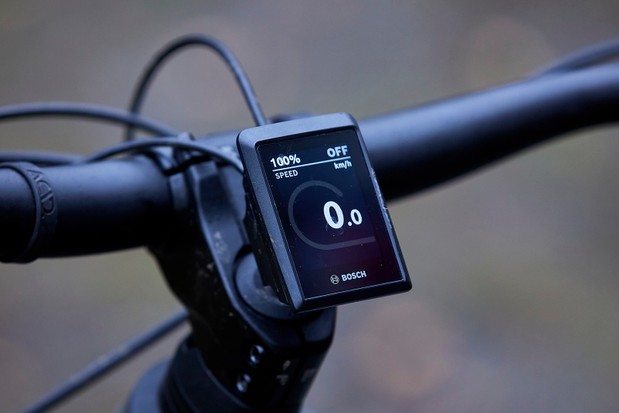
The most obvious overlap is their motors – both run the same Bosch Performance Line CX drive unit, powered by an in-frame PowerTube battery with a 750Wh capacity. They also share suspension designs, dampers and SRAM AXS wireless shifting.
Dig beneath the surface, however, and there are quite a few differences, the most obvious being frame material.
The Cube’s front triangle is made from carbon fibre – which, on paper at least, can be used to create a lighter chassis with a better blend of stiffness and comfort-boosting ‘compliance’ (engineered flex). The Whyte’s tubes are hydroformed aluminium.
Perhaps having more impact on the trail, though, is their geometry. The E-160 is long, low and slack, while the Stereo is a more traditional shape.
We tested these two bikes back-to-back on the trails used for the UK’s round of the Enduro World Series, in Scotland’s Tweed Valley, to see which approach works best in practice and give you the best idea of how they perform.
Introducing the bikes
Cube Stereo Hybrid 160 HPC SLT 750 27.5
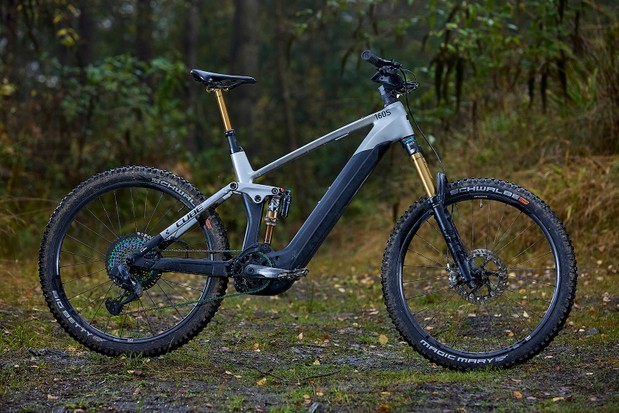
This range-topping, 650b-wheeled bike comes fully loaded, with a mainframe built from Cube’s top-spec C:62 HPC carbon fibre, Fox Factory suspension, Newmen carbon wheels and SRAM’s top XX1 Eagle AXS wireless drivetrain.
The headline geometry figures are slightly more reserved, though, including a 65-degree head angle, 76-degree seat tube angle, 479.8mm reach (on the large size we tested) and relatively high bottom bracket (BB).
Cube Stereo Hybrid 160 HPC SLT 750 27.5 details
- Cable management: Cube runs the dropper post cable and rear brake hose through the frame via the headset. As well as looking neat, Cube says this boosts strength (because it removes the need for holes in the head/down tube).
- Frame construction: The C:62 carbon fibre the Stereo 160 is made from is the brand’s highest-spec material.
- Parts spec: Getting SRAM’s halo XX1 Eagle AXS drivetrain on a sub-£10,000 bike is a real win, especially given the quality of the rest of the spec.
Cube Stereo Hybrid 160 HPC SLT 750 27.5 specifications
- Sizes: M, L, XL (L size tested)
- Weight: 24.17kg without pedals, size large
- Frame: C:62 Monocoque Advanced Twin Mold Technology front triangle, 6061-T6 aluminium rear triangle, 160mm (6.29in) travel
- Fork: Fox Float 38 Factory, 170mm (6.69in) travel
- Brakes: Magura MT7, 203/203mm rotors
- Crankset: e*thirteen Plus, 36t
- Derailleur(s): SRAM XX1 Eagle AXS (1×12)
- Shifter(s): SRAM XX1 Eagle AXS
- Cassette: SRAM XX1 Eagle, 10-52t
- Chain: SRAM XX1 Eagle
- Shock: Fox Float X Factory
- Motor/battery: Bosch Performance Line CX Smart System / PowerTube 750
- Headset: ACROS AZF-1035 ICR
- Wheelset: Newmen Advanced SL A.30
- Tyres: Schwalbe Magic Mary Super Trail Addix Soft 27.5×2.4in (f), Schwalbe Big Betty Super Trail Addix Soft 27.5×2.4in (r)
- Bar: Newmen Advanced 318.25, 780mm
- Stem: Cube Performance Stem E-MTB, 45mm
- Grips: ACID Disrupt
- Seatpost: Fox Transfer Factory (dropper)
- Saddle: Natural Fit Venec
- Price: £8,499 / €8,499
Cube Stereo Hybrid 160 HPC SLT 750 27.5 geometry
Whyte E-160 RSX
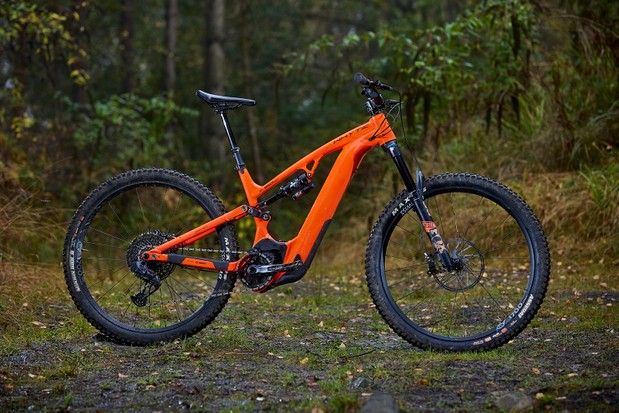
Another premium offering (only surpassed by the long-travel E-180), the E-160 has a decent spec, but, with its alloy frame, Performance Elite suspension and GX AXS gears, can’t match the Cube.
Geometry is more progressive, though – including a 63.8-degree head angle, 75.3-degree seat tube angle, 483mm reach and super-low 326mm BB height – plus Whyte has rotated the motor to lower the bike’s centre of gravity. You can run 29in wheels or a mullet setup.
Whyte E-160 RSX details
- Smart system: Bosch’s latest e-MTB hardware and software suite – found on both bikes here – combines the existing Performance Line CX motor with a new battery, controller options and eBike Flow app, which enables you to customise how the drive unit performs, record rides and more.
- Battery placement: Whyte uses Bosch’s rail system, where the battery slides into the down tube on a rail that isn’t structurally integral to the frame. Whyte says this means the down tube is stronger and stiffer than one with a battery ‘window’.
- Frame construction: The E-160’s 6061-T6 aluminium tubes are hydroformed – a process that uses high-pressure hydraulic fluid to press them into moulds – into complex shapes and are multi-butted (ie. wall thickness varies along their length) to give the best balance of strength and weight.
Whyte E-160 RSX specifications
- Sizes: M, L, XL (L size tested)
- Weight: 26.32kg without pedals, size large
- Frame: 6061-T6 hydroformed aluminium, 150mm (5.9in) travel
- Motor/battery: Bosch Performance Line CX Smart System / PowerTube 750
- Fork: Fox Float 38 Performance Elite, 160mm (6.29in) travel
- Brakes: SRAM Code RSC, 220/200mm rotors
- Shock: Fox Float X Performance Elite
- Headset: FSA Orbit
- Wheelset: DT Swiss HX 1700
- Tyres: Maxxis Assegai 3C MaxxGrip EXO+ TR 29×2.5in (f), Maxxis Minion DHRII 3C MaxxTerra DD 29×2.4in (r)
- Crankset: Race Face Aeffect, 36t
- Derailleur(s): SRAM GX Eagle AXS (1×12)
- Shifter(s): SRAM GX Eagle AXS
- Cassette: SRAM GX Eagle, 10-52t
- Chain: SRAM GX Eagle
- Bar: Race Face Turbine R, 800mm
- Stem: Race Face Atlas, 35mm
- Grips: Whyte Lock-On Enduro
- Seatpost: Crankbrothers Highline 3 (dropper)
- Saddle: Fizik Terra Aidon
- Price: £7,999
Whyte E-160 RSX geometry
How does the Cube Stereo Hybrid 160 HPC SLT 750 27.5 compare to the Whyte E-160 RSX?
Whether you’re hurtling down your favourite trail, picking lines instinctively and getting into a flow state, or you’re riding blind, a good bike should remove at least some of the guesswork, making it easier and more fun to try new ways down the hill, get a bit sketchy or push that bit harder.
Not only does an enduro electric bike have to do that on the descents, but it must also make the way up to the trailhead faster and less fatiguing. So, how do our two bikes measure up?
Seeking similarities
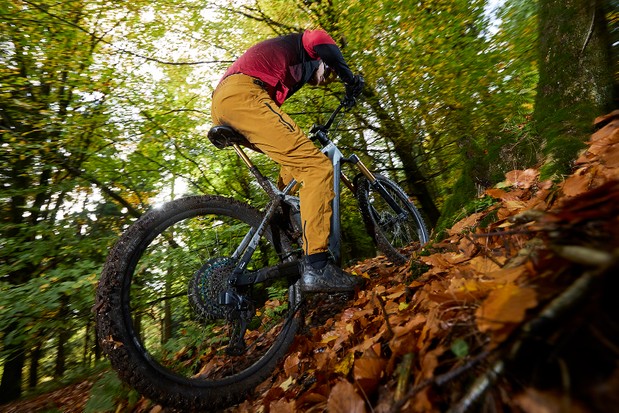
We’ll focus on the commonalities to begin with, the most obvious being the high-powered Bosch motor. Boasting 85Nm of peak torque and up to 340 per cent assistance, the Performance Line CX is the current benchmark for natural-feeling power assistance.
Bosch has worked hard on its latest Smart System tech, and two of the four modes – Tour+ and eMTB – now react to rider input, adjusting output according to how much effort you put in.
While this might sound like an obvious feature to include, only Bosch has so far managed to create such a powerful and rewarding system, where pedalling harder increases motor assistance in a meaningful way.
Both bikes also use Bosch’s most energy-dense PowerTube 750 battery. With 750Wh on tap, our 76kg tester managed to exceed 2,000m of ascending (and therefore descending) on a single charge with each bike in Tour+ mode.
Up assistance to eMTB or Turbo, however, and that range drops off significantly, to the point where exceeding 1,100m of climbing can be tricky on full power. Bosch’s eBike Flow smartphone app enables you to tune the assistance further.
Feeling Horst
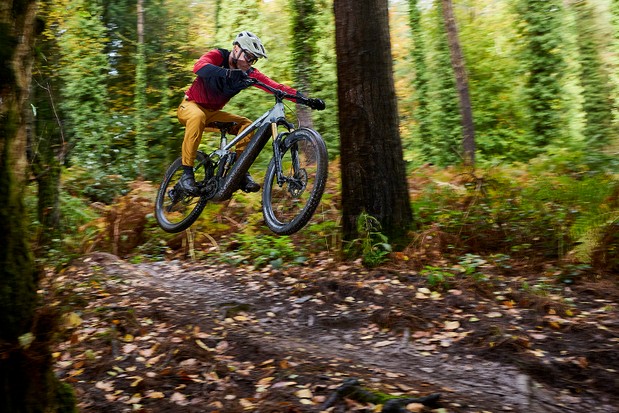
Less obviously, but just as importantly, the Cube and Whyte also share the same Horst- link rear suspension layout.
This system, made famous by Specialized’s FSR bikes, places a secondary pivot between the main pivot and rear-wheel axle, thus ‘disconnecting’ the wheel from the mainframe.
Thanks to the adaptability of the Horst-link design, manufacturers can tune the suspension kinematics of their bikes to suit specific needs.
In this case, both brands have made their bikes relatively progressive. The Stereo Hybrid 160’s leverage ratio ramps up by 28.3 per cent as it goes through its travel, making it well suited to both coil- and air-sprung shocks.
With 22 per cent progression, the E-160 is more suited to air shocks. Anti-rise (how much the suspension is influenced by braking forces) is between 50 and 65 per cent on both, so their rear ends should remain active when you’re on the anchors.
Both have similarly low anti-squat figures (how much the suspension is affected by pedalling forces), too – around 80 per cent at sag. This should help them feel smooth when travelling over rough terrain, but with a tendency to bob when you’re pedalling. This isn’t as much of an issue on an ebike, because the motor can compensate for any energy losses to unwanted suspension movement.
Specs appeal
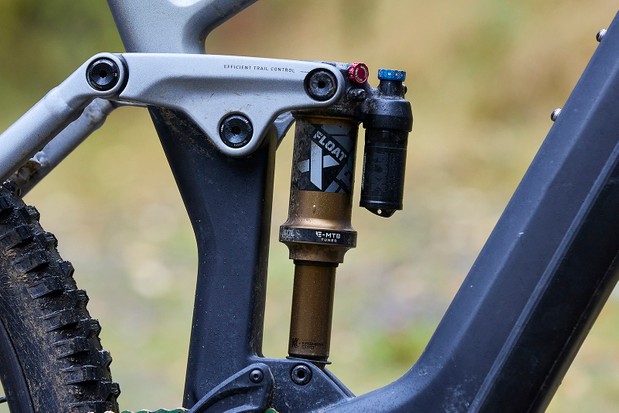
Take a deep dive into the bikes’ componentry and there are yet more similarities. A Fox 38 fork and Float X rear shock feature on both.
While the Whyte gets non-Kashima-coated Performance Elite versions, the internal damper tech and external adjustments are the same as on the showier Factory kit on the Cube. It’s the same with the drivetrains.
Although the Whyte is fitted with SRAM’s entry-level wireless groupset, GX Eagle AXS, it’s functionally identical to the pricier and slightly lighter XX1 Eagle AXS, and you won’t notice a difference in performance between the two.
That’s where the similarities end and rifts between the two bikes begin to appear, though.
Not only do they have different-size wheels, with the Whyte rolling on bigger 29in hoops and the Cube on smaller 650b (aka 27.5in) wheels, but the brands’ tyre choices are poles apart.
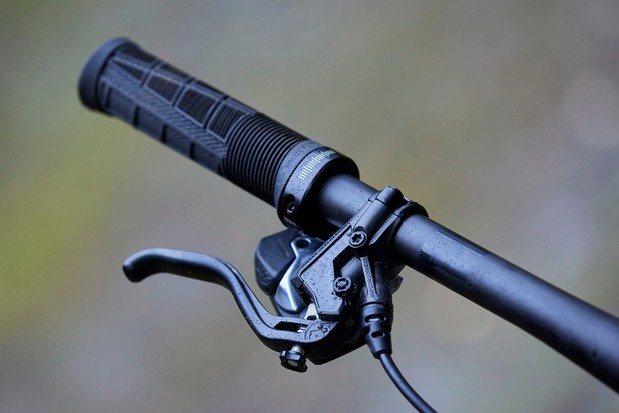
The E-160 has Maxxis rubber and the Stereo Hybrid 160, Schwalbe. However, it’s not the manufacturer of the tyres, but their compounds and casings, that differentiate the two.
The Whyte’s front tyre is a Maxxis Assegai with EXO+ casing and sticky 3C MaxxGrip compound, famed for its all-weather, all-surface traction, while out back there’s a Minion DHR II with less tacky but faster-rolling 3C MaxxTerra rubber and a DoubleDown casing tough enough for the rigours of electric mountain biking.
Cube, on the other hand, specs Schwalbe’s Super Trail casing and ADDIX Soft compound front and rear.
Although the Magic Mary and Big Betty tyres have excellent tread patterns, the lightweight casings and less grippy rubber let down the Cube’s otherwise impressive spec list.
Along with the carbon fibre frame, the lighter tyres do tip the scales in the Stereo Hybrid 160’s favour, though. Without pedals, our size-large bike weighed 24.17kg, compared to the E-160’s chunkier 26.32kg.
Alternate angles
The disparities between the two bikes deepen when you analyse their geometry. Whyte has worked its hardest to lower the E-160’s centre of gravity, rotating the front of the motor upwards so the battery fits partially beneath it.
This should improve how the bike corners and make it extra stable on rough terrain. Of course, a low centre of gravity alone doesn’t make for a good bike, but here it’s complemented by the Whyte’s geometry figures.
A slack 63.8-degree head angle and long 483mm reach and 446mm chainstays help keep things stable, while a 326mm bottom bracket height (all large frame, ‘low’ flip-chip position) adds to the low-slung cornering feel.
At 65 degrees, the Cube’s head angle is much steeper than the Whyte’s. The BB is also higher (335mm), despite its smaller wheels. While the reach figure is similar (479.8mm, large), the chainstays are shorter (441.5mm).
On paper, all this should add up to a less stable feel on the trail. The Stereo Hybrid 160 does have a steeper seat tube angle than the E-160, though, its 76-degree figure beating the Whyte’s 75.3 degrees, which should make seated climbing easier and more comfortable.
Trail-bound
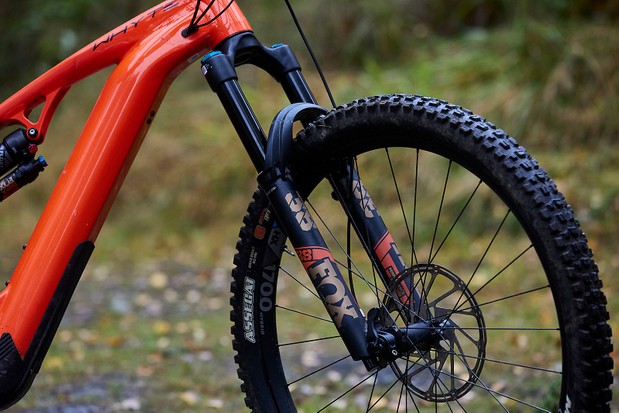
While geometry numbers, suspension charts, spec lists and headline weights give an indication of performance, it’s on the trail where a bike’s mettle is proven. Point these two machines uphill and differences are instantly apparent.
The Whyte’s riding position is traditional, in terms of how your body weight is shared between the saddle and handlebar, with a bias towards the seat. Your feet are also placed in front of your hips, rather than directly beneath them.
This detracts from climbing performance and comfort, because it means you need to make more weight shifts to keep the front wheel from going too light and wandering or lifting.
On steep ascents, this is exaggerated further, because more weight is transferred to the rear wheel, compressing the bike’s suspension beyond the sag point.
Riding the Whyte in isolation, you wouldn’t necessarily notice this, but when you swap to the E-160 from the Stereo Hybrid 160 it feels like stepping out of a Mini Cooper and into a stretch limousine.
The Cube’s seated climbing position is positively upright, with the bar and front wheel close to the centre of the bike, and bodyweight evenly distributed between saddle and bar.
Add in the steeper seat tube angle, and the Stereo Hybrid 160 is a surprisingly proficient climber. Smaller movements are needed to keep it on course, or to stop the front wheel from lifting or the rear one from spinning.
Agility is the Cube’s strong point, but the flipside to this is that when things do get close to the edge of control on particularly technical climbs, the bike is much harder to rein back in, with only soft, finessed weight shifts doing the trick.
Bringing up the rear
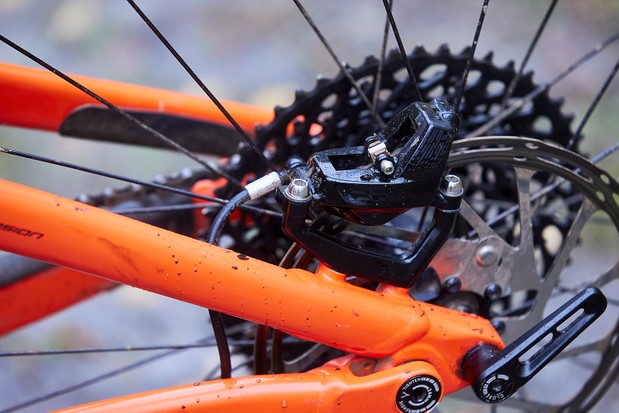
On both bikes, the suspension feels similar – which is unsurprising, given their doppelganger kinematics – working hard to create good levels of comfort and grip on a wide range of trail surfaces.
The Whyte is marginally smoother than the Cube, with an extra plushness that means it handles being pummelled into high-frequency, low-amplitude bumps well.
Its custom-tuned Float X damper is impressive, blending great small-bump sensitivity with big-hit capability. While we used full travel frequently, we rarely felt a corresponding loss of control or composure.
The only sign it had happened was the position of the O-ring on the stanchion, and harsh bottom-outs were few and far between. Although the additional progression of the Hybrid Stereo 160 would improve the E-160’s handling further, it does well with the leverage ratios it has.
The Cube’s progressive suspension makes up for some of its shortcomings elsewhere. It helps to compensate for its less long, low and slack geometry and makes it feel more stable and confidence-inspiring on chunky trails, with no fear of bottoming-out or losing control.
It also means there’s no price to pay for heavy gas-to-flat landings, making the Stereo Hybrid 160 a solid companion through harder hits and big, successive bumps.
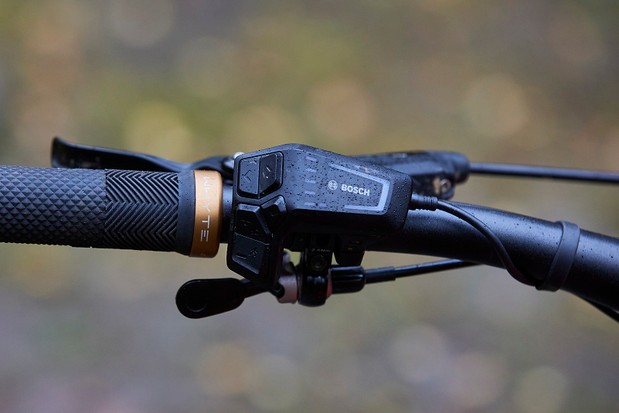
However, while the Cube’s suspension does a lot of the donkey work when it comes to smoothing out bumpy surfaces, its ride is undeniably raw in feel, with smaller, sharper bumps resonating through the bar and pedals, creating harshness.
We had to run the Super Trail tyres at higher pressures than the EXO+/DD rubber on the Whyte so the lighter casings wouldn’t puncture or roll in corners. This will have influenced the ride feel.
However, we don’t think this was the only factor. It’s likely the carbon fibre frame, wheels and perhaps the bar, too, all play their role in making the Stereo Hybrid 160 less forgiving than we’d like.
One of carbon’s benefits as a frame and component material is that, by manipulating the way the fibres and resin are laid up, you can tune the ride feel.
Here, it feels like stiffness and strength-to-weight ratios have been prioritised over comfort-boosting ‘compliance’.
In contrast, the Whyte has a smooth ride, and that’s not just down to its suspension. While aluminium has a reputation for unyielding stiffness, careful tube shaping can introduce a decent amount of ‘give’.
Here, the frame construction, combined with some well-chosen parts – including tyres that feel well-damped and high-end alloy wheels from DT Swiss – results in a bike that balances vibration-absorption with precision well.
Eating up the bumps
If smoothness is the E-160’s entrée, the main course is its stability. Over bumpy, gnarly terrain it remains perfectly poised and balanced. The contact points stay impressively level as the front and rear wheels work overtime to absorb the trail’s contours, isolating you from the rough.
The less you do, the faster and better the Whyte feels, and it’s happy to take on most of the heavy lifting for you. Get things wrong or work the bike too hard, and there’s virtually no price to pay, as the stable chassis filters out any rider-based mistakes.
The upshot is that hard trails feel easier, or can be ridden significantly faster, because you don’t have to focus on keeping the bike under control.
The Cube, on the other hand, has a nervous, almost skittish feel on steeper, faster, gnarlier descents. Its steering is twitchy and requires constant micro-adjustments.
With its short-feeling cockpit and steeper head angle, it lacks the Whyte’s stability, and requires lots of rider input to stay on track. However, a fine balance needs to be struck.
Bigger, more assertive movements and weight shifts can affect the Stereo Hybrid 160’s trajectory to the point where it can shoot off-line. Continual small, light and intentional inputs get the most from the bike, but this is a fatiguing way to ride.
Cornering contest
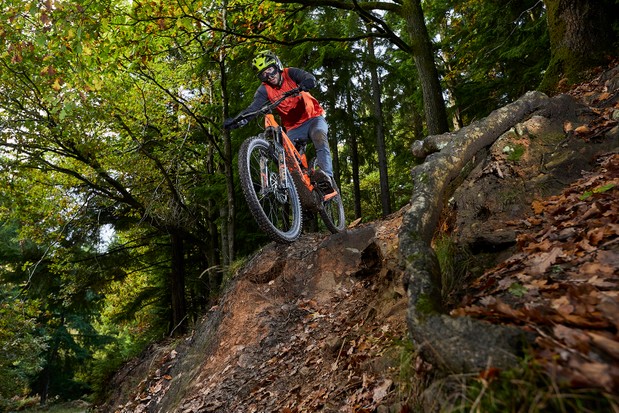
Both bikes feel great in the turns, but for different reasons. The Whyte squats firmly into your chosen arc, not budging until you want it to.
It’s still responsive to changes in direction, though – in fact, surprisingly so, considering its low-slung BB and high level of stability.
Swapping from one edge of the tyre to the other is quick and effortless, with no twitchiness. How much the bike moves is directly related to the effort you put in, and in this respect the E-160 hides its 26.32kg weight well.
The Cube chops and changes direction quickly, requiring less rider input to change its course than the longer, slacker bike, which makes weaving in and out of trees at lower speeds great fun.
Its smaller wheels help here, too, while its supportive, poppy suspension gives plenty to drive against in banked turns or to generate grip.
When the chips are down
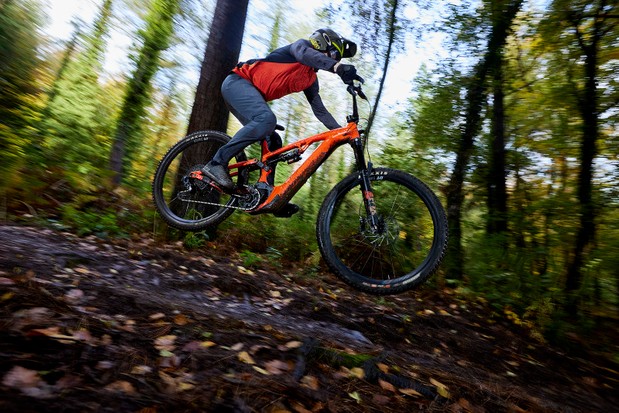
With its pearlescent paintjob, svelte tubing and top-tier components, the Stereo Hybrid 160 has big appeal on the showroom floor, but we’d take the impressively rounded, and rather exceptional, performance of the E-160 over the glossy looks of the Cube any day.
By lowering the bike’s centre of gravity as far as it could and matching it with correspondingly progressive geometry, Whyte has made one of the best-handling ebikes we’ve ridden to date.
It feels masterfully calm and composed on every trail or feature, but is also brilliantly responsive to rider inputs. This makes its performance as close to irreproachable as you can get, and there’s a real magic to the way it descends.
The Cube’s raw-feeling ride is hard to ignore and harder yet to master, requiring lots of care and precision to get it to ride as well as its parts list and price tag suggest it should.
Its spec shortcomings can be solved with upgrades – such as tougher, better-damped tyres – but its frame feel and geometry are set in stone, and, unfortunately, these play the biggest role in how the Stereo Hybrid 160 performs.
It’s not all bad news, because if you ride tighter, flatter trails the Cube will perform well, but that’s not the type of terrain it’s been designed for.
Overall verdict
Whyte E-160 RSX
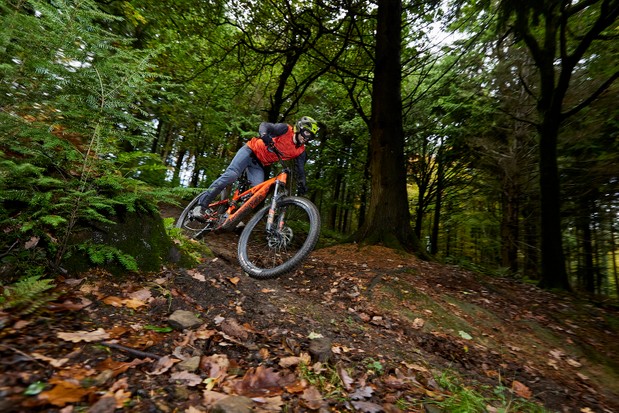
Masterful in almost every situation, the E-160 RSX sets a new benchmark for big-hitting e-bike performance on a reasonable budget
Cube Stereo Hybrid 160 HPC SLT 750 27.5
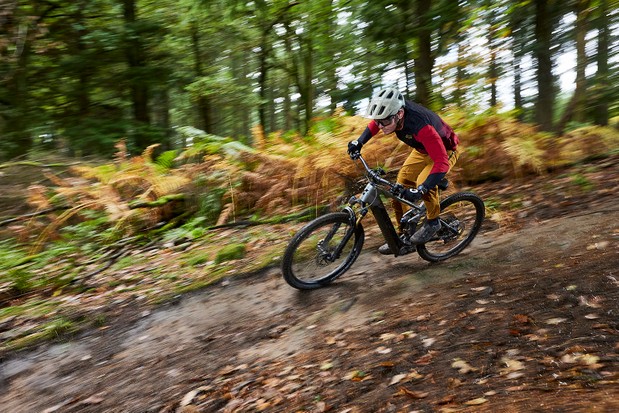
The Stereo Hybrid 160 has a harsh, raw-feeling ride that needs patience and skill to master, but it is good on flatter, tamer tracks


